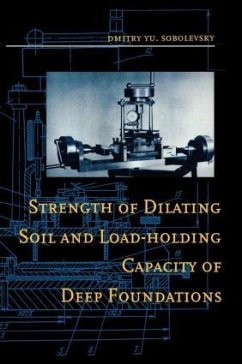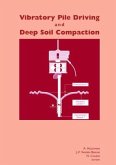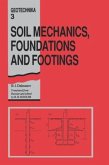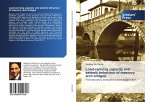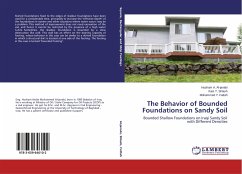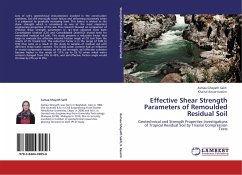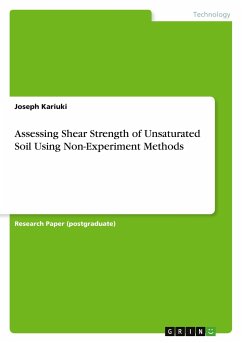D. Yu Sobolevsky
Strength of Dilating Soil and Load-holding Capacity of Deep Foundations
Introduction to theory and practical applications
D. Yu Sobolevsky
Strength of Dilating Soil and Load-holding Capacity of Deep Foundations
Introduction to theory and practical applications
- Gebundenes Buch
- Merkliste
- Auf die Merkliste
- Bewerten Bewerten
- Teilen
- Produkt teilen
- Produkterinnerung
- Produkterinnerung
Introduces the theory and practical application of dilating soil and the load-holding capacity of deep foundations. Topics covered include dilatancy as a fundamental property of granular media, direct shear in conditions of constrained dilatancy, and load-holding capacity of a single pile.
Andere Kunden interessierten sich auch für
![Deep Foundations on Bored and Auger Piles - BAP III Deep Foundations on Bored and Auger Piles - BAP III]() W. Haegeman / W.F. Impe (eds.)Deep Foundations on Bored and Auger Piles - BAP III204,99 €
W. Haegeman / W.F. Impe (eds.)Deep Foundations on Bored and Auger Piles - BAP III204,99 €![Vibratory Pile Driving and Deep Soil Compaction Vibratory Pile Driving and Deep Soil Compaction]() N. Charue / A. Holeyman (eds.)Vibratory Pile Driving and Deep Soil Compaction64,99 €
N. Charue / A. Holeyman (eds.)Vibratory Pile Driving and Deep Soil Compaction64,99 €![Soil Mechanics, Footings and Foundations Soil Mechanics, Footings and Foundations]() B. I. DalmatovSoil Mechanics, Footings and Foundations536,99 €
B. I. DalmatovSoil Mechanics, Footings and Foundations536,99 €![Load-carrying capacity and seismic behaviour of masonry arch bridges Load-carrying capacity and seismic behaviour of masonry arch bridges]() Stefano De SantisLoad-carrying capacity and seismic behaviour of masonry arch bridges64,99 €
Stefano De SantisLoad-carrying capacity and seismic behaviour of masonry arch bridges64,99 €![The Behavior of Bounded Foundations on Sandy Soil The Behavior of Bounded Foundations on Sandy Soil]() Husham A. Al-janabiThe Behavior of Bounded Foundations on Sandy Soil49,99 €
Husham A. Al-janabiThe Behavior of Bounded Foundations on Sandy Soil49,99 €![Effective Shear Strength Parameters of Remoulded Residual Soil Effective Shear Strength Parameters of Remoulded Residual Soil]() Asmaa Gheyath SalihEffective Shear Strength Parameters of Remoulded Residual Soil33,99 €
Asmaa Gheyath SalihEffective Shear Strength Parameters of Remoulded Residual Soil33,99 €![Assessing Shear Strength of Unsaturated Soil Using Non-Experiment Methods Assessing Shear Strength of Unsaturated Soil Using Non-Experiment Methods]() Joseph KariukiAssessing Shear Strength of Unsaturated Soil Using Non-Experiment Methods42,95 €
Joseph KariukiAssessing Shear Strength of Unsaturated Soil Using Non-Experiment Methods42,95 €-
-
-
Introduces the theory and practical application of dilating soil and the load-holding capacity of deep foundations. Topics covered include dilatancy as a fundamental property of granular media, direct shear in conditions of constrained dilatancy, and load-holding capacity of a single pile.
Hinweis: Dieser Artikel kann nur an eine deutsche Lieferadresse ausgeliefert werden.
Hinweis: Dieser Artikel kann nur an eine deutsche Lieferadresse ausgeliefert werden.
Produktdetails
- Produktdetails
- Verlag: CRC Press
- Seitenzahl: 256
- Erscheinungstermin: 1. Januar 1995
- Englisch
- Abmessung: 260mm x 183mm x 18mm
- Gewicht: 683g
- ISBN-13: 9789054101642
- ISBN-10: 9054101644
- Artikelnr.: 24383321
- Herstellerkennzeichnung
- Libri GmbH
- Europaallee 1
- 36244 Bad Hersfeld
- gpsr@libri.de
- Verlag: CRC Press
- Seitenzahl: 256
- Erscheinungstermin: 1. Januar 1995
- Englisch
- Abmessung: 260mm x 183mm x 18mm
- Gewicht: 683g
- ISBN-13: 9789054101642
- ISBN-10: 9054101644
- Artikelnr.: 24383321
- Herstellerkennzeichnung
- Libri GmbH
- Europaallee 1
- 36244 Bad Hersfeld
- gpsr@libri.de
Dmitry Yu. Sobolevsky was bom on 8 August 1959 in Minsk, Belarus. In 1198 U graduated from the Byelorussian State Polytechnical Academy (BSPA), Faculty of Civil Engineering. His Ph. D. thesis, which he defended in 1985, treated ground anchors an& in 1993 he delivered his D.Sc. thesis on dilatancy problems in soil mechanics at St. Petersburg Technical University. D. Yu. Sobolevsky worked as a lecturer in the field of geotechnics and researcher in soil mechanics of BSPA. He is known in Belarus and other cou^^s of the former USSR as a consultant and specializes in deep foundations, underground constructions, grouting and anchoring. In 1994 he became the Head of the Department for Geotechnics .and? Environmental Engineering of BSPA, the main geotechnical organization of Belarus.
Introduction
Part 1: Strength of dilating non
cohesive soil
1 Dilatancy as a fundamental property of granular media
1.1 On the term 'dilatancy'
1.2 Interaction of grains in non
cohesive soils
1.3 Changes in soil density in the process of failure
1.4 Plastic and elastic deformations of non
cohesive soils
1.5 Dilatancy and the stress condition of soil
1.6 Examples of free and constrained dilatancy
1.7 Manifestation of dilatancy in soil strength tests
1.8 Conclusion
2 Models of elasto
plastic deformations of dilating non
cohesive soil
2.1 General propositions
2.2 Models of contact shear
2.3 'Soil
to
soil' shear model
2.4 Model of internal bulge
2.5 Justification of the assumption regarding elastic reaction of the massif to dilatancy
2.6 Conclusion
3 Instruments and methods for soil testing in the conditions of constrained dilatancy
3.1 General propositions
3.2 Dilatometric Apparatus of Contact Shear (DACS)
3.3 Dilatometric Apparatus of Direct Shear (DADS)
3.4 Special testing method with the use of the serial shear apparatus BCB
25
3.5 Dilatometric Apparatus of Contact Shear of reinforcing elements (DACS
A)
3.6 Dilatometric Triaxial Apparatus (DTA)
3.7 Conclusion
4 Contact shear in conditions of constrained dilatancy
4.1 General propositions
4.2 The influence of dilatancy constraint on resistance of soil to contact shear
4.3 Dilatant component of strength as a function of massif elasticity
4.4 Angle of contact friction as a function of massif elasticity
4.5 The influence of initial soil density and grain size
4.6 Influence of moisture content
4.7 Values of dilatant strains
4.8 Influence of grain strength
4.9 Critical density and critical normal pressure
4.10 Peak and residual strength of sands
4.11 On reasons for curvature of function xu = f(Gn )
4.12 Cyclic shear in conditions of constrained dilatancy
5 Direct shear in conditions of constrained dilatancy
5.1 General propositions
5.2 Influence of constraint on dilatancy on resistance to shear
5.3 Dilatant component of strength and angle of internal friction as functions of massifs elasticity
5.4 Comparison and peculiarities of tests in dilatometric instruments of various designs
5.5 Conclusion
6 Internal bulge as a manifestation of conditions of constrained dilatancy
6.1 General propositions
6.2 Influence of dilatancy on stress
deformative condition of soil during triaxial compression
6.3 Adjustments for dilatancy in Coulomb
Mohr's strength conditions
6.4 Angle of internal friction as a function of massif elasticity
6.5 Peculiarities of soil deformation with constrained dilatancy
6.6 Conclusion
7 Conditions of strength of dilating non
cohesive soil
7.1 General propositions
7.2 Ultimate resistance to shear
7.3 Ultimate state during triaxial compression
7.4 Conclusion
Part 2. Deep foundations in dilating soil
8 Constrained dilatancy as a factor of load
holding capacity of deep foundations
8.1 General propositions
8.2 Bore piles of Type 1
8.3 Bore piles of Type 2 and footings of Type 1
8.4 Bore piles of Type 3
8.5 Bore piles of Types 4, 5 and footings of Types 2, 3
8.6 Injection piles and anchors
8.7 Piles constructed with soil displacement
8.8 Factors of stress
deformative condition at the contour of a bore pile
8.9 Conclusion: Reasons for the failures of theoretical calculation methods
9 Load
holding capacity of a single pile
9.1 Calculating scheme
9.2 Propositions regarding calculation of bore piles
9.3 Propositions for calculating bore piles with injected base and shaft
9.4 Propositions for calculating injection piles
9.5 Propositions for calculating piles manufactured with displacement of soil
9.6 Conclusion
10 Load
holding capacity of a deep footing
10.1 Calculating scheme
10.2 Load
holding capacity along the skin surface
10.3 Load
holding capacity at the lower end
10.4 Equation for calculating the total load
holding capacity
10.5 Conclusion
11 Load
holding capacity of an injection anchor
11.1 Calculating scheme
11.2 Contact resistance to shear along the root surface
11.3 Critical length of compressed root
11.4 Equation for calculating the load
holding capacity
11.5 Group effect of anchors
11.6 Conclusion
12 Sketches of several dilatancy manifestations
12.1 Reinforced earth as a composite material
12.2 Distortion and liquefaction of sands
12.3 Dilatant nature of contact filtration and negative friction along the pile shafts
12.4 Realization of the factor of dilatant strength during tunnelling
12.5 Dilatancy and seismic activity
12.6 Dilatancy in cracks of stone constructions
12.7 Reinforced concrete as a dilating composite material
General conclusions
Appendix 1
Appendix 2
References
Subject
index.
Part 1: Strength of dilating non
cohesive soil
1 Dilatancy as a fundamental property of granular media
1.1 On the term 'dilatancy'
1.2 Interaction of grains in non
cohesive soils
1.3 Changes in soil density in the process of failure
1.4 Plastic and elastic deformations of non
cohesive soils
1.5 Dilatancy and the stress condition of soil
1.6 Examples of free and constrained dilatancy
1.7 Manifestation of dilatancy in soil strength tests
1.8 Conclusion
2 Models of elasto
plastic deformations of dilating non
cohesive soil
2.1 General propositions
2.2 Models of contact shear
2.3 'Soil
to
soil' shear model
2.4 Model of internal bulge
2.5 Justification of the assumption regarding elastic reaction of the massif to dilatancy
2.6 Conclusion
3 Instruments and methods for soil testing in the conditions of constrained dilatancy
3.1 General propositions
3.2 Dilatometric Apparatus of Contact Shear (DACS)
3.3 Dilatometric Apparatus of Direct Shear (DADS)
3.4 Special testing method with the use of the serial shear apparatus BCB
25
3.5 Dilatometric Apparatus of Contact Shear of reinforcing elements (DACS
A)
3.6 Dilatometric Triaxial Apparatus (DTA)
3.7 Conclusion
4 Contact shear in conditions of constrained dilatancy
4.1 General propositions
4.2 The influence of dilatancy constraint on resistance of soil to contact shear
4.3 Dilatant component of strength as a function of massif elasticity
4.4 Angle of contact friction as a function of massif elasticity
4.5 The influence of initial soil density and grain size
4.6 Influence of moisture content
4.7 Values of dilatant strains
4.8 Influence of grain strength
4.9 Critical density and critical normal pressure
4.10 Peak and residual strength of sands
4.11 On reasons for curvature of function xu = f(Gn )
4.12 Cyclic shear in conditions of constrained dilatancy
5 Direct shear in conditions of constrained dilatancy
5.1 General propositions
5.2 Influence of constraint on dilatancy on resistance to shear
5.3 Dilatant component of strength and angle of internal friction as functions of massifs elasticity
5.4 Comparison and peculiarities of tests in dilatometric instruments of various designs
5.5 Conclusion
6 Internal bulge as a manifestation of conditions of constrained dilatancy
6.1 General propositions
6.2 Influence of dilatancy on stress
deformative condition of soil during triaxial compression
6.3 Adjustments for dilatancy in Coulomb
Mohr's strength conditions
6.4 Angle of internal friction as a function of massif elasticity
6.5 Peculiarities of soil deformation with constrained dilatancy
6.6 Conclusion
7 Conditions of strength of dilating non
cohesive soil
7.1 General propositions
7.2 Ultimate resistance to shear
7.3 Ultimate state during triaxial compression
7.4 Conclusion
Part 2. Deep foundations in dilating soil
8 Constrained dilatancy as a factor of load
holding capacity of deep foundations
8.1 General propositions
8.2 Bore piles of Type 1
8.3 Bore piles of Type 2 and footings of Type 1
8.4 Bore piles of Type 3
8.5 Bore piles of Types 4, 5 and footings of Types 2, 3
8.6 Injection piles and anchors
8.7 Piles constructed with soil displacement
8.8 Factors of stress
deformative condition at the contour of a bore pile
8.9 Conclusion: Reasons for the failures of theoretical calculation methods
9 Load
holding capacity of a single pile
9.1 Calculating scheme
9.2 Propositions regarding calculation of bore piles
9.3 Propositions for calculating bore piles with injected base and shaft
9.4 Propositions for calculating injection piles
9.5 Propositions for calculating piles manufactured with displacement of soil
9.6 Conclusion
10 Load
holding capacity of a deep footing
10.1 Calculating scheme
10.2 Load
holding capacity along the skin surface
10.3 Load
holding capacity at the lower end
10.4 Equation for calculating the total load
holding capacity
10.5 Conclusion
11 Load
holding capacity of an injection anchor
11.1 Calculating scheme
11.2 Contact resistance to shear along the root surface
11.3 Critical length of compressed root
11.4 Equation for calculating the load
holding capacity
11.5 Group effect of anchors
11.6 Conclusion
12 Sketches of several dilatancy manifestations
12.1 Reinforced earth as a composite material
12.2 Distortion and liquefaction of sands
12.3 Dilatant nature of contact filtration and negative friction along the pile shafts
12.4 Realization of the factor of dilatant strength during tunnelling
12.5 Dilatancy and seismic activity
12.6 Dilatancy in cracks of stone constructions
12.7 Reinforced concrete as a dilating composite material
General conclusions
Appendix 1
Appendix 2
References
Subject
index.
Introduction
Part 1: Strength of dilating non
cohesive soil
1 Dilatancy as a fundamental property of granular media
1.1 On the term 'dilatancy'
1.2 Interaction of grains in non
cohesive soils
1.3 Changes in soil density in the process of failure
1.4 Plastic and elastic deformations of non
cohesive soils
1.5 Dilatancy and the stress condition of soil
1.6 Examples of free and constrained dilatancy
1.7 Manifestation of dilatancy in soil strength tests
1.8 Conclusion
2 Models of elasto
plastic deformations of dilating non
cohesive soil
2.1 General propositions
2.2 Models of contact shear
2.3 'Soil
to
soil' shear model
2.4 Model of internal bulge
2.5 Justification of the assumption regarding elastic reaction of the massif to dilatancy
2.6 Conclusion
3 Instruments and methods for soil testing in the conditions of constrained dilatancy
3.1 General propositions
3.2 Dilatometric Apparatus of Contact Shear (DACS)
3.3 Dilatometric Apparatus of Direct Shear (DADS)
3.4 Special testing method with the use of the serial shear apparatus BCB
25
3.5 Dilatometric Apparatus of Contact Shear of reinforcing elements (DACS
A)
3.6 Dilatometric Triaxial Apparatus (DTA)
3.7 Conclusion
4 Contact shear in conditions of constrained dilatancy
4.1 General propositions
4.2 The influence of dilatancy constraint on resistance of soil to contact shear
4.3 Dilatant component of strength as a function of massif elasticity
4.4 Angle of contact friction as a function of massif elasticity
4.5 The influence of initial soil density and grain size
4.6 Influence of moisture content
4.7 Values of dilatant strains
4.8 Influence of grain strength
4.9 Critical density and critical normal pressure
4.10 Peak and residual strength of sands
4.11 On reasons for curvature of function xu = f(Gn )
4.12 Cyclic shear in conditions of constrained dilatancy
5 Direct shear in conditions of constrained dilatancy
5.1 General propositions
5.2 Influence of constraint on dilatancy on resistance to shear
5.3 Dilatant component of strength and angle of internal friction as functions of massifs elasticity
5.4 Comparison and peculiarities of tests in dilatometric instruments of various designs
5.5 Conclusion
6 Internal bulge as a manifestation of conditions of constrained dilatancy
6.1 General propositions
6.2 Influence of dilatancy on stress
deformative condition of soil during triaxial compression
6.3 Adjustments for dilatancy in Coulomb
Mohr's strength conditions
6.4 Angle of internal friction as a function of massif elasticity
6.5 Peculiarities of soil deformation with constrained dilatancy
6.6 Conclusion
7 Conditions of strength of dilating non
cohesive soil
7.1 General propositions
7.2 Ultimate resistance to shear
7.3 Ultimate state during triaxial compression
7.4 Conclusion
Part 2. Deep foundations in dilating soil
8 Constrained dilatancy as a factor of load
holding capacity of deep foundations
8.1 General propositions
8.2 Bore piles of Type 1
8.3 Bore piles of Type 2 and footings of Type 1
8.4 Bore piles of Type 3
8.5 Bore piles of Types 4, 5 and footings of Types 2, 3
8.6 Injection piles and anchors
8.7 Piles constructed with soil displacement
8.8 Factors of stress
deformative condition at the contour of a bore pile
8.9 Conclusion: Reasons for the failures of theoretical calculation methods
9 Load
holding capacity of a single pile
9.1 Calculating scheme
9.2 Propositions regarding calculation of bore piles
9.3 Propositions for calculating bore piles with injected base and shaft
9.4 Propositions for calculating injection piles
9.5 Propositions for calculating piles manufactured with displacement of soil
9.6 Conclusion
10 Load
holding capacity of a deep footing
10.1 Calculating scheme
10.2 Load
holding capacity along the skin surface
10.3 Load
holding capacity at the lower end
10.4 Equation for calculating the total load
holding capacity
10.5 Conclusion
11 Load
holding capacity of an injection anchor
11.1 Calculating scheme
11.2 Contact resistance to shear along the root surface
11.3 Critical length of compressed root
11.4 Equation for calculating the load
holding capacity
11.5 Group effect of anchors
11.6 Conclusion
12 Sketches of several dilatancy manifestations
12.1 Reinforced earth as a composite material
12.2 Distortion and liquefaction of sands
12.3 Dilatant nature of contact filtration and negative friction along the pile shafts
12.4 Realization of the factor of dilatant strength during tunnelling
12.5 Dilatancy and seismic activity
12.6 Dilatancy in cracks of stone constructions
12.7 Reinforced concrete as a dilating composite material
General conclusions
Appendix 1
Appendix 2
References
Subject
index.
Part 1: Strength of dilating non
cohesive soil
1 Dilatancy as a fundamental property of granular media
1.1 On the term 'dilatancy'
1.2 Interaction of grains in non
cohesive soils
1.3 Changes in soil density in the process of failure
1.4 Plastic and elastic deformations of non
cohesive soils
1.5 Dilatancy and the stress condition of soil
1.6 Examples of free and constrained dilatancy
1.7 Manifestation of dilatancy in soil strength tests
1.8 Conclusion
2 Models of elasto
plastic deformations of dilating non
cohesive soil
2.1 General propositions
2.2 Models of contact shear
2.3 'Soil
to
soil' shear model
2.4 Model of internal bulge
2.5 Justification of the assumption regarding elastic reaction of the massif to dilatancy
2.6 Conclusion
3 Instruments and methods for soil testing in the conditions of constrained dilatancy
3.1 General propositions
3.2 Dilatometric Apparatus of Contact Shear (DACS)
3.3 Dilatometric Apparatus of Direct Shear (DADS)
3.4 Special testing method with the use of the serial shear apparatus BCB
25
3.5 Dilatometric Apparatus of Contact Shear of reinforcing elements (DACS
A)
3.6 Dilatometric Triaxial Apparatus (DTA)
3.7 Conclusion
4 Contact shear in conditions of constrained dilatancy
4.1 General propositions
4.2 The influence of dilatancy constraint on resistance of soil to contact shear
4.3 Dilatant component of strength as a function of massif elasticity
4.4 Angle of contact friction as a function of massif elasticity
4.5 The influence of initial soil density and grain size
4.6 Influence of moisture content
4.7 Values of dilatant strains
4.8 Influence of grain strength
4.9 Critical density and critical normal pressure
4.10 Peak and residual strength of sands
4.11 On reasons for curvature of function xu = f(Gn )
4.12 Cyclic shear in conditions of constrained dilatancy
5 Direct shear in conditions of constrained dilatancy
5.1 General propositions
5.2 Influence of constraint on dilatancy on resistance to shear
5.3 Dilatant component of strength and angle of internal friction as functions of massifs elasticity
5.4 Comparison and peculiarities of tests in dilatometric instruments of various designs
5.5 Conclusion
6 Internal bulge as a manifestation of conditions of constrained dilatancy
6.1 General propositions
6.2 Influence of dilatancy on stress
deformative condition of soil during triaxial compression
6.3 Adjustments for dilatancy in Coulomb
Mohr's strength conditions
6.4 Angle of internal friction as a function of massif elasticity
6.5 Peculiarities of soil deformation with constrained dilatancy
6.6 Conclusion
7 Conditions of strength of dilating non
cohesive soil
7.1 General propositions
7.2 Ultimate resistance to shear
7.3 Ultimate state during triaxial compression
7.4 Conclusion
Part 2. Deep foundations in dilating soil
8 Constrained dilatancy as a factor of load
holding capacity of deep foundations
8.1 General propositions
8.2 Bore piles of Type 1
8.3 Bore piles of Type 2 and footings of Type 1
8.4 Bore piles of Type 3
8.5 Bore piles of Types 4, 5 and footings of Types 2, 3
8.6 Injection piles and anchors
8.7 Piles constructed with soil displacement
8.8 Factors of stress
deformative condition at the contour of a bore pile
8.9 Conclusion: Reasons for the failures of theoretical calculation methods
9 Load
holding capacity of a single pile
9.1 Calculating scheme
9.2 Propositions regarding calculation of bore piles
9.3 Propositions for calculating bore piles with injected base and shaft
9.4 Propositions for calculating injection piles
9.5 Propositions for calculating piles manufactured with displacement of soil
9.6 Conclusion
10 Load
holding capacity of a deep footing
10.1 Calculating scheme
10.2 Load
holding capacity along the skin surface
10.3 Load
holding capacity at the lower end
10.4 Equation for calculating the total load
holding capacity
10.5 Conclusion
11 Load
holding capacity of an injection anchor
11.1 Calculating scheme
11.2 Contact resistance to shear along the root surface
11.3 Critical length of compressed root
11.4 Equation for calculating the load
holding capacity
11.5 Group effect of anchors
11.6 Conclusion
12 Sketches of several dilatancy manifestations
12.1 Reinforced earth as a composite material
12.2 Distortion and liquefaction of sands
12.3 Dilatant nature of contact filtration and negative friction along the pile shafts
12.4 Realization of the factor of dilatant strength during tunnelling
12.5 Dilatancy and seismic activity
12.6 Dilatancy in cracks of stone constructions
12.7 Reinforced concrete as a dilating composite material
General conclusions
Appendix 1
Appendix 2
References
Subject
index.

